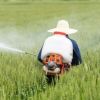Discover our range of high-quality technical-grade herbicide ingredients, meticulously formulated to deliver potent weed control and ensure maximum crop yield:
– Glyphosate 95% TC
– Atrazine 97% TC
– Clodinafop Propargyl 97% TC
– Cloquintocet-Mexyl (Safener) 97% TC
– Metribuzin 97% TC
– Bispyribac Sodium 95% TC
– Paraquat 42% TC
Each ingredient is meticulously manufactured to meet stringent quality standards, ensuring purity and potency that farmers can rely on. Whether applied pre- or post-emergence, these herbicides offer effective control over a wide range of weeds, helping farmers maintain clean and healthy fields throughout the growing season.
In addition to their efficacy, our herbicide ingredients prioritize safety for both crops and the environment. By minimizing phytotoxicity and off-target effects, our formulations allow for precise weed control while preserving the health of desirable plants and surrounding ecosystems. Furthermore, our commitment to sustainable agriculture drives us to continually innovate and improve, seeking out new solutions that minimize environmental impact without compromising performance.
With our technical-grade herbicide ingredients, farmers can approach weed management with confidence, knowing they have access to reliable tools backed by scientific research and field-tested results. Whether tackling stubborn perennial weeds, controlling grassy invaders, or preparing fields for planting, our products provide the efficacy and versatility needed to meet the challenges of modern agriculture.
Area of use
In agriculture, farmers extensively rely on technical herbicides to control weeds and unwanted vegetation in crop fields, orchards, vineyards, and plantation crops such as corn, soybeans, wheat, rice, cotton, and sugarcane. Consequently, these products enable farmers to maximize crop yields by minimizing weed competition and ensuring healthy crop growth.
Similarly, in forestry operations, practitioners employ technical herbicides to manage vegetation in forest plantations, clearings, and logging sites. They play a crucial role in suppressing competing vegetation, promoting the growth of desired tree species, and preventing the establishment of invasive plants that may disrupt forest ecosystems.
Moreover, in non-agricultural landscapes, users apply technical herbicides in settings such as parks, golf courses, recreational areas, roadside verges, and industrial sites to control weeds and maintain aesthetically pleasing environments. They utilize these products to manage vegetation along roadsides, railways, utility corridors, and other rights-of-way, ensuring safety, visibility, and access for transportation and infrastructure maintenance activities.
How to store
Cool, Dry Location: Store technical herbicides in a cool, dry, and well-ventilated area away from direct sunlight, heat sources, and moisture. Exposure to extreme temperatures and humidity can degrade the product and reduce its effectiveness.
Secure Container: Keep the herbicides in their original tightly sealed containers to prevent leakage, spills, and contamination. Ensure that the containers are undamaged and securely closed to avoid exposure to air and moisture.
Out of Reach of Children and Pets: Store technical herbicides in a secure area that is inaccessible to children, pets, and unauthorized individuals. Consider using locked cabinets or storage areas to prevent accidental ingestion or exposure.











Reviews
There are no reviews yet.